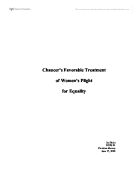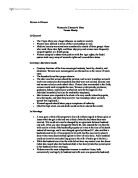In the male-dominated literature of the times, it was common for men to speak of the woes of marriage. In Alison’s Prologue, she argues that she is also worthy of speaking of the woes of marriage because of her worldly experience:
Experience… / Were in this world, is right ynogh for me
To speke of wo that is in marriage (l. 1-3).
Chaucer implies that—although his audience is not used to hearing of women’s woes in marriage—they do exist.
Chaucer’s Alison further embodies feminism by defying Catholic virtues of virginity, saying that celibacy is for people who aspire to be perfect, whereas she does not. She defends herself by comparing her life to Abraham and Jacob, stating that each had at least two wives:
Abraham was a hooly man,
And Jacob eek, as fer as ever I kan,
And ech of them hadde wivew mo than two (l. 55-57)
Chaucer attacks the hypocrisy of modern man by making biblical comparisons, allowing Alison to justify her behavior. Throughout the Wife’s Prologue, Alison misapplies references to Bible text but successfully uses them to mock traditional religious-legal doctrine and age-old theology, which sanctioned and authorized male prejudice and dominion (Maclaine 103).
In order to show how Alison became so worldly and wise, Chaucer dedicates much of the prologue to discussion of her several marriages and the injustices inflicted upon her. Here, the wife explains that she gave all her worldly possessions and land to her husband, since she loved him so much:
Hath wedded me with greet solempnitee,
And to him yaf I all the lond and fee
That evere was me yiven therebifore (l. 629-631)
Alison proceeds by depicting his ingratitude and her naivety:
But afterward repented me ful sore.
He nolde suffer nothing of my list (l. 632-634)
She explains that her husband ceased to respect her and refused to grant her anything she would request. Chaucer goes to great lengths to describe the injustices, which are common in the patriarchal society of his time.
Chaucer empowers Alison—in a revolutionary manner—when he describes how she earned the respect of her husband. Alison states that her husband would often cite a particular book of proverbs of antifeminist and anti-matrimonial anecdotes. Alison goes on to say that she considered the book to be denigrating and that her anger became unbearable:
I saugh he wolde nevere fine
To redden on this cursed book all night,
All sodeynly three leves have I plight
Out of his book right as he radde, and eke
I with my fest so took him on the cheke (l. 788-792)
Here, Chaucer enthralls Alison’s audience by depicting a woman physically lashing out against her husband, hence defying patriarchal authority. The book is symbolic of the patriarchal wisdom—undisputed by Chaucer’s society, and she defies it.
In an even stronger turn of events, Alison forces her husband to burn the book, hence submitting to her will and putting himself at her mercy:
He yaf me all the bridel in mine hond,
To han governance of hous and lond…
And made him brenne his book anon right tho (l. 813-816)
In accordance with feminist ideals, the husband not only submits but also gives up control over the household and land, in exchange for her forgiveness.
Alison empowers the female reader by explaining that she won her own sovereignty by fighting for her freedom. “I hadde giten unto me / By maistrie all the soveraynetee”(l. 817). Chaucer relentlessly awes his male audience and empowers his female audience.
In trying to make Chaucer’s audience sympathize with Alison’s plight, he describes the “happily ever after” conclusion to her prologue:
After that day we hadden never debaat.
God help me so, I was to him so kinde
As any wife…/ And also trewe, and so has he to me (l. 823-826)
Alison conveys that her husband’s submission was the best thing that could have happened, since they lived happily from that day forward. Chaucer attempts to teach the audience that it is unnecessary to dominate women, clearly sympathetic with their plight.
In order to further distance himself from the audience, Chaucer engages Alison in telling her tale. In a witty twist, she depicts the protagonist of her tale as a knight in King Arthur’s Court and eventually degrades him to a convicted rapist, putting his life at the mercy of the queen and ladies of her court. By taking a knight, the epitome of chivalry and tarnishing his image with an immoral injustice, Chaucer is able to reveal the hypocrisy, which exists even amongst the higher classes. This depiction of hypocrisy amongst men is meant to empower women.
Alison describes—in her tale—that the knight’s fate is at the mercy of the queen and the ladies of her court. The queen proposes a stimulating psychological undertaking. The queen decides to delay his sentencing for twelve months, during which he is supposed to determine “what thing it is that women most desire.” The purpose of this journey is to provide the rapist with an opportunity to radically change his male chauvinist views, such that he will learn to respect women. If the knight fails, he will be sentenced to death. Chaucer not only encourages the audience to wonder about the fate of the knight, but he also encourages men to question what women desire most, in hopes that they might learn to treat women with more equality.
Toward the end of the knight’s yearlong quest, Alison explains that he meets a loathsome old woman that professes to know the answer he seeks. In exchange for his promise to grant her one wish, she enlightens him: “Wommen desiren to have soverayntee / as well over hir housband as hir love, and for to been in maistrie hym above” (l. 1044-1046). Herein, Chaucer is stating that—in his opinion—women want to rule over mankind, especially in marriage. Clearly, these are extremely feminist views for the Middle Ages.
Alison is empowered, since her audience desires to discover what women desire most, and she holds the answer. Alison’s possession of this knowledge makes her an authority figure over men during this tale—a revolutionary convention for Chaucer’s time. She explains, at the end of this yearlong quest, that the knight appeals to the queen and the ladies of the court with his response to their question. None of them denies its accuracy, and he is pardoned for his crime. Women are further empowered by being presented as judge and jury.
Alison continues her tale and states that the knight promised to wed the loathsome old woman in exchange for the answer to his question. The knight is reluctant to fulfill his promise but at the mercy of the queen and her court—he does so. Chaucer further empowers women, making them judge and jury, once again.
On the night of their wedding, the knight and his new wife retire to their chamber, in order to consummate their wedding vows. At this time, she acknowledges his reluctance to have sex:
Fareth every knight thus with his wyf as ye?
Is this the lawe of Kyng Arthures hous?
Is every knight of his so dangerous? (l. 1094-1096)
Herein, the audience bears witness to the knight’s hypocrisy. His wife questions his reluctance to fulfill his marital obligations. Chaucer depicts a knight who is able to immorally steal a young maiden’s virginity, but is simultaneously unwilling to have sex with his own wife. Chaucer, once again places man at the mercy of a woman, in order to teach him a lesson.
At the conclusion Alison’s tale, the knight—symbolic of mankind—puts his fate in his wife’s hands, an ideal image in feminism. When the wife asks him whether he would prefer her to be young and unfaithful or old and loyal, he says:
My lady and my love, and wyf so dere,
I putte me in youre wise governance:
Cheseth yourself which may be most plesaunce
And most honour to you and me also (l. 1236-1239)
In saying this, the knight relinquishes all authority over his wife and gives her full command over their marriage. When the knight’s loathly wife realizes that his hypocrisy and chauvinist tendencies have disappeared, she transforms into a young and beautiful woman. Alison hereby implies that all husbands should likewise give in to their wives. Chaucer’s remarkable and fairytale-like ending is intended to convince men that women should be treated with more equality.
In conclusion, Geoffrey Chaucer depicts and exaggerates the corruption and injustices commonly experienced during his lifetime. By utilizing the character of Alison, the Wife of Bath, as an instrument, Chaucer is able to address the taboo subject of inequality towards women. By disguising himself as Alison, hence empowering a female protagonist, Chaucer is able to urge his audience to consider and reconsider patriarchal society’s treatment of women.
Works Cited
Beidler, Peter G. “The Wife of Bath.” Case Studies in Contemporary Criticism. New
York: Bedford Books of St. Martin’s Press, 1996. 4-6
Chaucer, Geoffrey. “The Canterbury Tales.” The Norton Anthology of English
Literature. Alfred David and E. Talbot Donaldson. New York: W.W. Norton &
Company, 2000. 215-272.
Maclaine, Allan H. The Student’s Comprehensive Study to the Canterbury Tales. New
York: Barron’s Educational Series, Inc., 1964. 101-105.







